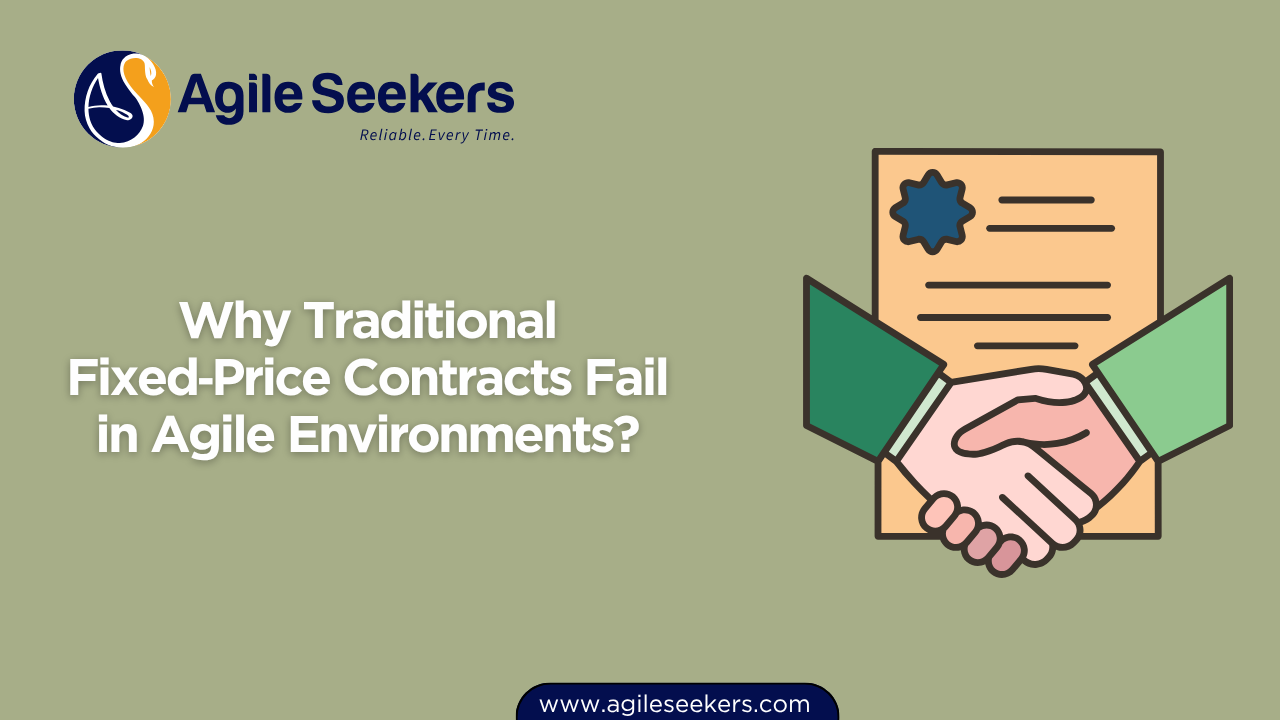Why Traditional Fixed‑Price Contracts Fail in Agile Environments?

Traditional fixed‑price contracts were built for projects that had clear, unchanging requirements. These contracts assume that scope, timeline, and cost can be locked down at the start—a principle known as the iron triangle. But in Agile environments, where change is expected, customer feedback drives development, and iterative value delivery is core, fixed-price contracts often fail to deliver.
Let’s explore why.
1. The Iron Triangle vs. Agile Mindset
In fixed‑price contracts, the iron triangle (scope, cost, and time) is locked early. Success is measured by adherence to the original plan. But Agile thrives on adaptability. The Agile Manifesto values responding to change over following a plan. These two models are fundamentally at odds.
In an Agile environment:
-
Scope evolves based on feedback.
-
Priorities shift to deliver the most valuable features first.
-
Teams inspect and adapt frequently.
When a supplier is tied to fixed commitments, there’s little room for iterative discovery or course correction. This creates friction between delivering what’s valuable and delivering what was initially scoped—often leading to dissatisfaction on both sides.
2. Example: The Government Portal That Missed the Mark
Consider a government agency that contracts a vendor to build a citizen-facing portal. The contract locks in 200 specific features over 12 months for a fixed ₹2 crore. Halfway through, after user testing, the agency realizes some features aren’t needed, and others—never considered initially—are critical.
But changing scope means change requests, renegotiation, and delays. The vendor, operating on a fixed margin, resists any deviation without extra billing. The project slows, user value is compromised, and the relationship turns adversarial.
In contrast, Agile contracts would have allowed room to re-prioritize based on feedback. The agency could have achieved a better outcome, even if some lower-priority items were never delivered.
3. Win–Lose Dynamics in Fixed Contracts
Fixed-price models can create win–lose relationships:
-
If the vendor underestimates effort, they lose money or cut corners.
-
If they overestimate, the client overpays for perceived risk.
-
Any change results in a “change request war.”
This dynamic discourages collaboration. Instead of working together to find the best outcome, both parties focus on protecting themselves—often to the project’s detriment.
Agile, on the other hand, encourages shared risk and reward. A Scrum Master trained through a SAFe Scrum Master Certification often facilitates conversations that shift the focus from deliverables to customer outcomes.
4. The Hidden Cost of Early Locked Scope
Fixed contracts assume the customer knows exactly what they need from day one. This is rarely true.
In software, requirements emerge over time. Locking the scope too early leads to:
-
Gold-plating: Building unnecessary features.
-
Waste: Rework from misunderstood or outdated requirements.
-
Technical debt: Hasty decisions made to meet contractual milestones.
Instead, Agile teams welcome evolving understanding. Certified professionals from programs like the SAFe Product Owner/Product Manager (POPM) Certification are trained to groom backlogs continuously and deliver what’s most valuable at every iteration.
5. Better Alternatives: Agile Contracting Models
Several Agile contract models address these limitations:
a. Incremental or Iteration-Based Contracts
Clients pay for a fixed number of sprints or iterations. At the end of each cycle, they can reassess priorities or discontinue. This allows flexibility without long-term lock-in.
b. Capacity-Based Contracts
Clients pay for team capacity (e.g., two teams over 6 months) rather than specific scope. Value is measured through delivered outcomes, not feature checklists.
c. Outcome-Based Contracts
Payment is tied to measurable business outcomes, not predefined deliverables. This aligns incentives and keeps the focus on customer success.
Agile Release Train (ART) leaders, often trained through the SAFe Release Train Engineer (RTE) Certification, play a key role in coordinating these dynamic contract models across multiple teams.
6. Legal and Procurement Hesitations
Many legal and procurement departments are still tied to traditional models. They fear lack of control, compliance risks, and difficulty justifying iterative payments. But these challenges can be addressed:
-
Transparency through working software – Agile makes progress visible.
-
Frequent reviews – Empowers oversight without micro-management.
-
Frameworks like SAFe – Encourage alignment across portfolio and team levels.
Programs like the Leading SAFe Agilist Certification help leaders understand how to scale these practices across the enterprise and build trust with stakeholders.
7. From Command and Control to Collaboration
Agile contracts demand a mindset shift: from controlling scope to collaborating on outcomes.
Architects, product managers, and team leads must learn to communicate value over velocity. The SAFe Advanced Scrum Master Certification equips facilitators to manage cross-team dynamics and ensure feedback flows into contract discussions.
8. When Agile Contracts Work Best
Agile contracting is especially effective when:
-
The environment is complex and evolving (e.g., product innovation, customer-facing apps).
-
Stakeholders are engaged and available for feedback.
-
Outcomes are more important than predefined features.
For reference, frameworks like Agile Contracting at Scale from the Scaled Agile Framework offer guidance on building trust-based, flexible contracting models that empower both parties.
Conclusion: Contract for Collaboration, Not Control
Fixed-price contracts were designed for predictable outcomes. But Agile work is dynamic and learning-driven. The mismatch creates risk, waste, and friction.
Agile environments demand partnership over prescription, and flexibility over fixation. Shifting to modern Agile contracting models allows vendors and customers to co-create value instead of clinging to outdated assumptions.
For organizations adopting SAFe, investing in certifications like SAFe Scrum Master, SAFe POPM, and SAFe RTE can accelerate this transformation and help bridge the gap between delivery and value.
Also read - How Agile Architecture Helps Modernize Safely and Incrementally
Also see - Introducing the SAFe “Managed‑Investment Contract”




















